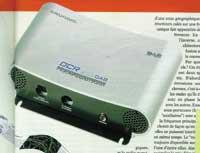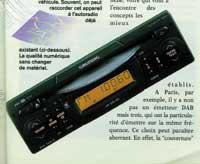DAB or digital radio

They have been testing and improving with the DAB digital radio for years, but it seems that thanks to the advances made in 1988 in Strasbourg, the system is ready for marketing. The new system achieved excellent sound quality, at the level of the current CDs. But he had a big obstacle. In fact, the size of the DAB system radio receiver was very large and needed for itself the entire car boot. Therefore, such a large device could not be sold and the DAB system has been discarded, since then there were not enough "powerful" miniaturized electronic components to get the size of conventional car radio receivers.
The barrier to overcome was, of course, the size and the large European manufacturers of hifi material to face the challenge in 1991 (Philips, Thomson, Grundig, Blaupunkt, etc.) were united. It has taken almost ten years to overcome technological difficulties and commercialize the DAB system.
Advantages of DAB
However, DAB technology has nothing to do with traditional radio technologies. In Paris, for example, there is more than one radio station broadcasting at a certain frequency, three. This is very negative in the usual FM broadcasts, as interference occurs when in the same territory there is more than one station that broadcasts on the same frequency. However, DAB technology does not occur. Moreover, with several stations of the same frequency in the same place, the sound sounds better.
To do this, the stations have two particularities. On the one hand their emissions are synchronous, that is, the waves they emit are in phase. On the other hand, they maintain auxiliary frequencies at the main frequency. They are selected so that not all interfere with each other simultaneously. So the message (word or sound) is always prepared at least once. In this way, instead of having a single point emitter, we will have three at the same time and in the territory they occupy there would be no "shadow".
Problems with echoes on FM radios do not exist if DAB technology is used. Radio waves are reflected in mountains, buildings, bridges, etc. and hinder direct broadcasting. However, in the DAB system, points of reflection by not interfering with all auxiliary frequencies never at the same time become “auxiliary emitters” and help greater and better propagation of waves.
Digital system
The sound transmission in the DAB system is digital. The frequency of broadcasting is not modulated with the music to be transmitted. Instead, the sequence of "0" and "1" is sent, i.e. the numerical dataset. As with the compact disc, an electronic device analyzes the sound thousands of times per second and makes it a "package" consisting of "0" and "1".

Scanning, however, generates a large number of data per second and is "compressed" to limit the amount, eliminating the frequencies that the person cannot hear. To do this, the DAB system uses the MPEG audio standard, which is used by the Mini Disc. In other words, sound becomes a succession of data packets.
Since the amount of data that can be emitted by the DAB transmitter in a single frequency is much higher than that required by a program, up to eight programs are simultaneously broadcast, by rotating data issuance of eight programs respectively. This is what experts call multiplexing. This series of stations is called "DAB block". In addition, in each block data that is not "sounds" are also sent, but of transmission of texts or images.
DAB network deployment
This digital radio system is mature enough to have a wide market. It is already established in France in the big cities (Paris, Lyon, Marseille, Toulouse and Nantes) and this year will be extended to other cities (Lille, Bordeaux, Nice, Strasburg and Grenoble). On the other hand, shortly some houses will begin to market small radio receivers.
For this new network to succeed it has to take over the territory, but it also needs stations and listeners. But will listeners feel the need to spend on the DAB system? The one who circulates between the noise in the car, by himself, wants better than the one he has now?

In studies to date, most users have agreed to the DAB system. 78% of respondents have been willing to acquire the DAB receiver, although they now have a conventional car radio. They want to hear a better sound, but especially when traveling by car they do not want to hear parasites and do not want to have accidental cuts in programs. All this is clearly seen when the same program is heard by FM and at the same time by DAB. Also, when the car is running, the difference is even greater. In the FM on the way is lost at all times stereo, parasites occur and sometimes bad loops are heard. There is nothing like this in the DAB system.
Data and advertising
In addition to sound, digital radio can broadcast text and image data. On the face of DAB radio receivers there is a small screen that can give text on several lines. In a first phase, program name, radio station name, etc. will issue short messages about time or traffic. Soon the radio receiver will have a small auxiliary color screen. In it the motorist will have besides texts, images. Their main function will be to indicate where the big jams are, but they will also have an appropriate place to introduce advertising.
The radio channel offers the motorist the possibility of this interaction. In fact, the DAB system has the ability to issue many images, but as the screen will only display one of them, the others will be stored in the radio receiver's memory. Afterwards, through the buttons, the driver can see them all using the same system that has on the Internet. Each page of the screen will be encoded in the HTLM system (hypertext mark-up language), that is, in the format used by the Web.
Buletina
Bidali zure helbide elektronikoa eta jaso asteroko buletina zure sarrera-ontzian











